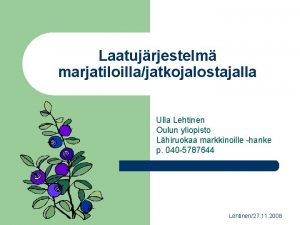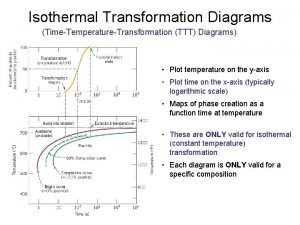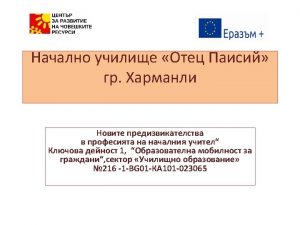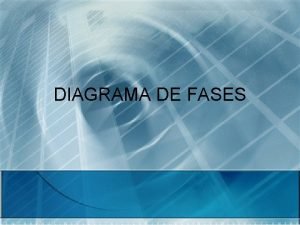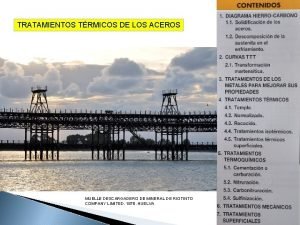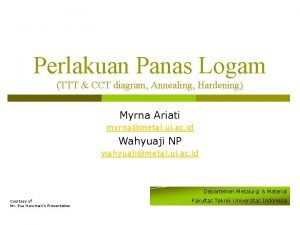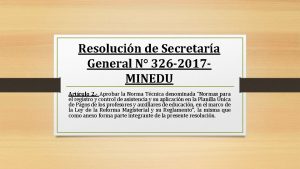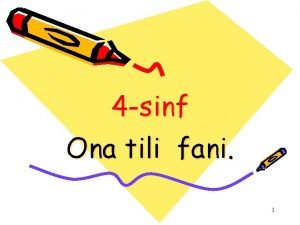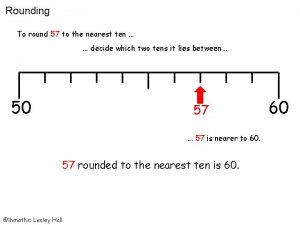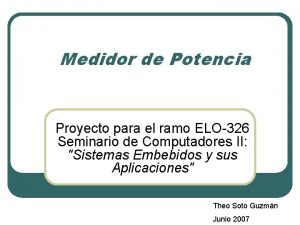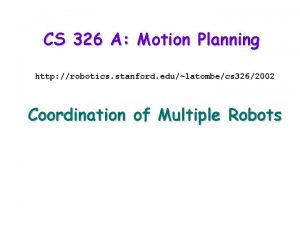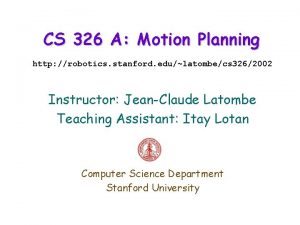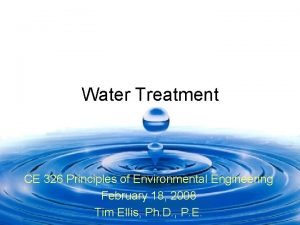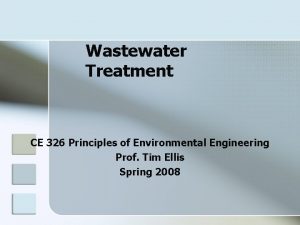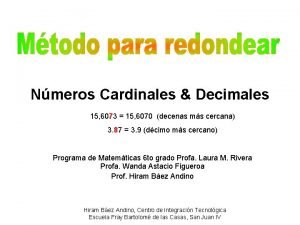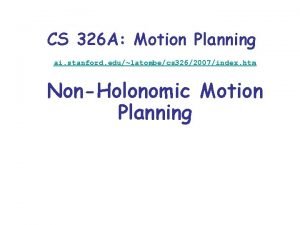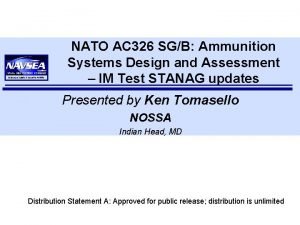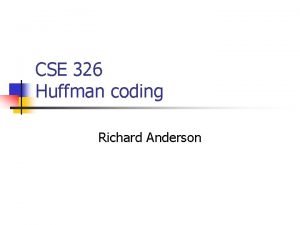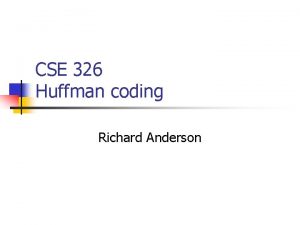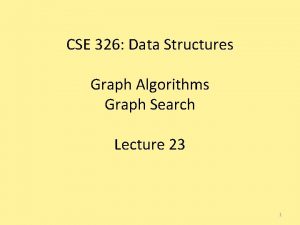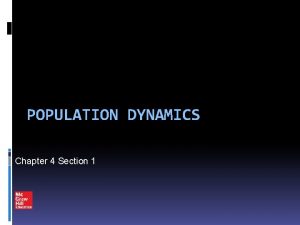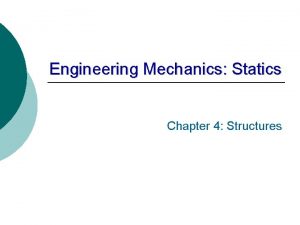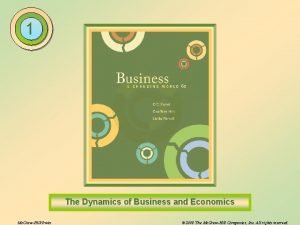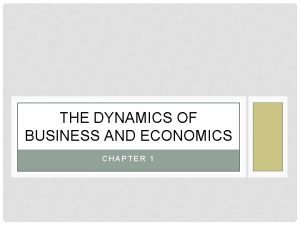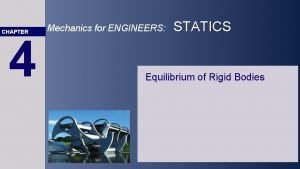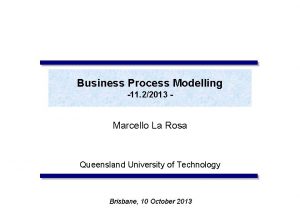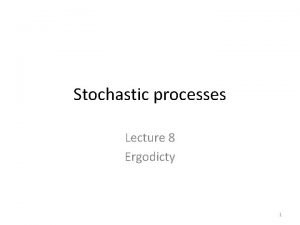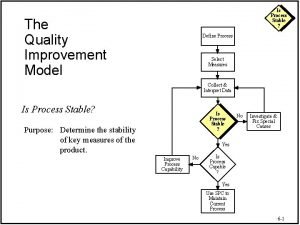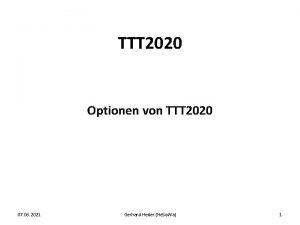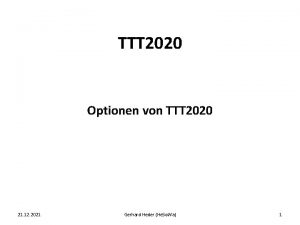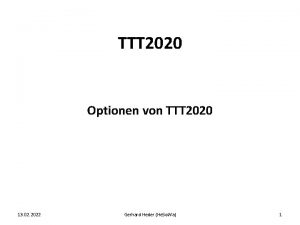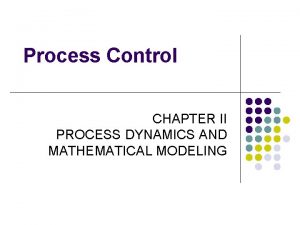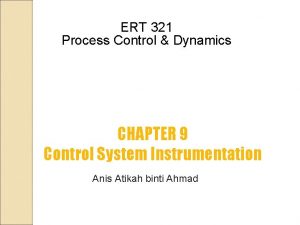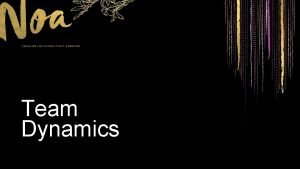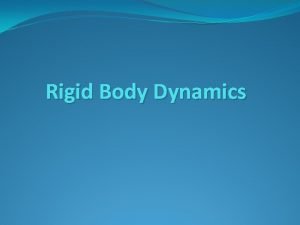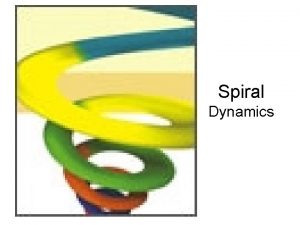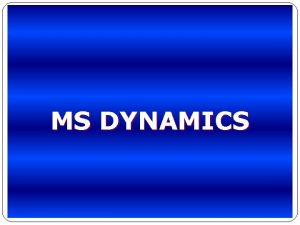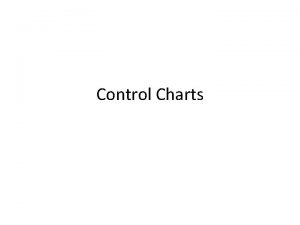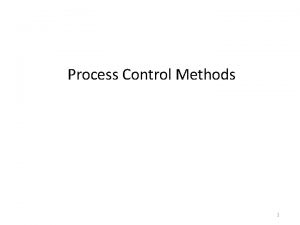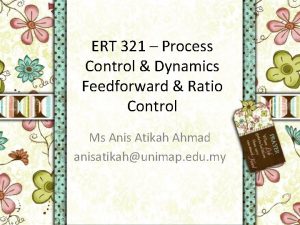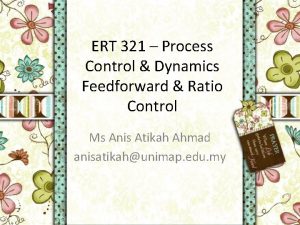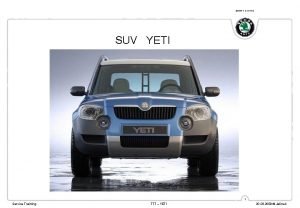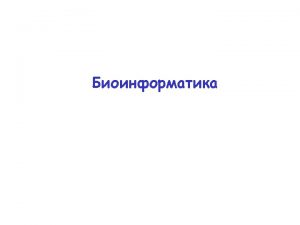TTT 326 Process Control Dynamics CHAPTER 9 Control












































- Slides: 44

TTT 326 Process Control & Dynamics CHAPTER 9 Control System Instrumentation Abdul Latif Bin Abdul Rani Slides edited from: Anis Atikah binti Ahmad

OUTLINE • Transducers & Transmitters • Final Control Elements (FCE) • Calculation of size of control valve • Transmission Line

CONTROL SYSTEM INSTRUMENTAT C Measureme nt Actuator Process A controller/process interface Actuator : is a component of machines that is responsible for moving or controlling a mechanism or system

Transducers & Transmitters Figure 9. 3 A typical process transducer. • Figure 9. 3 illustrates the general configuration of a measurement transducer; it typically consists of a sensing element combined with a driving element (transmitter). 1

• Transducers for process measurements convert the magnitude of a process variable (e. g. , flow rate, pressure, temperature, level, or concentration) into a signal that can be sent directly to the controller. • The sensing element is required to convert the measured quantity, that is, the process variable, into some quantity more appropriate for mechanical or electrical processing within the transducer. 2

Standard Instrumentation Signal Levels • Before 1960, instrumentation in the process industries utilized pneumatic (air pressure) signals to transmit measurement and control information almost exclusively. • These devices make use of mechanical force-balance elements to generate signals in the range of 3 to 15 psig, an industry standard. • Since about 1960, electronic instrumentation has come into widespread use. • Most industrial analogue instrumentation now has a standard 4 to 20 m. A range.

Sensors The main categories of measurements used in process control are temperature, pressure, flow rate, liquid level and composition. Selection criteria: 1. Measurement range (Span): • The required measurement range for the process variable must be entirely within the range of instrument performance 2. Performance: • Accuracy, repeatability, etc • The speed of response must be included in a closed loop control system.

3. Reliability: • Data available from the manufacturers provide baseline conditions. 4. Materials of construction: • The instrument may need to withstand high temperatures, high pressures, and corrosive and abrasive environments. For some applications, seals & purges may be necessary.

5. Prior use: • For the first installation of a specific measurement device at a site, training of maintenance personnel and purchases of spare parts might be necessary 6. Potential for releasing process materials to the environment: • Preventing exposure to fugitive emissions for maintenance personnel is important when the process fluid is corrosive or toxic. • Sterility in bioprocesses must be maintained. 7. Electrical classification • If the measurement device is not inherently compatible with possible exposure to hazards, suitable enclosures must be purchased & included in the installation costs.

Transmitters • A transmitter usually converts the sensor output to a signal level appropriate for input to a controller, such as 4 to 20 m. A. • Transmitters are generally designed to be direct acting. • In addition, most commercial transmitters have an adjustable input range (or span). • For example, a temperature transmitter might be adjusted so that the input range of a platinum resistance element (the sensor) is 50 to 150 °C. • In this case, the following correspondence is obtained: Input Output 50 °C 4 m. A 150 °C 20 m. A

• This instrument (transducer) has a lower limit or zero of 50 °C and a range or span of 100 °C. • For the temperature transmitter discussed above, the relation between transducer output and input is 20 m. A 4 m. A Tm m. A T 50°C 4 m. A 150° C 50°C m. A 0. 16 T °C 4 m. A °C The gain of the measurement element Km is 0. 16 m. A/°C. For any linear instrument: range of instrument output Km range of instrument input (9 -1)

Chapter 9 Figure 9. 4 A linear instrument calibration showing its zero and span.

Final Control Elements • Every process control loop contains a final control element (actuator), the device that enables a process variable to be manipulated. • For most chemical and petroleum processes, the final control elements (usually control valves) adjust the flow rates of materials, and indirectly, the rates of energy transfer to and from the process.

Control Valves • There are many different ways to manipulate the flows of material and energy into and out of a process; for example, the speed of a pump drive, screw conveyer, or blower can be adjusted. • However, a simple and widely used method of accomplishing this result with fluids is to use a control valve, also called an automatic control valve. • The control valve components include the valve body, trim, seat, and actuator. Air-to-Open vs. Air-to-Close Control Valves • Normally, the choice of A-O or A-C valve is based on safety considerations. 7

• We choose the way the valve should operate (full flow or no flow) in case of a transmitter failure. • Hence, A-C and A-O valves often are referred to as fail-open and fail-closed, respectively.

Chapter 9 Figure 9. 7 A pneumatic control valve (air-to-open). 8

Example 9. 1 Pneumatic control valves are to be specified for the applications listed below. State whether an A-O or A-C valve should be used for the following manipulated variables and give reason(s). a) Steam pressure in a reactor heating coil. b) Flow rate of reactants into a polymerization reactor. c) Flow of effluent from a wastewater treatment holding tank into a river. d) Flow of cooling water to a distillation condenser.

a) Steam pressure in a reactor heating coil. A-O (fail closed) to make sure that the transmitter failure will not cause the reactor to overheat, which is usually more serious than having it operate at too low temperature

b) Flow rate of reactants into a polymerization reactor. A-O (fail closed) to prevent the reactor from being flooded with excessive reactant. A-C (fail open) if the reactor flow rate normally is close to the maximum flow rate of the valve so that opening the valve fully would cause relatively little change in operating conditions.

(c) Flow of effluent from a wastewater treatment holding tank a river. A-O (fail closed) to prevent excessive and perhaps untreated waste from entering the stream.

(c) Flow of cooling water to a distillation condenser. A-C (fail open) to ensure that overhead vapor is completely condensed before it reaches the receiver.

Valve Positioners Pneumatic control valves can be equipped with a valve positioner, a type of mechanical or digital feedback controller that senses the actual stem position, compares it to the desired position, and adjusts the air pressure to the valve accordingly. 10

Calculation of size of control valve Specifying and Sizing Control Valves A design equation used for sizing control valves relates valve lift A to the actual flow rate q by means of the valve coefficient Cv, the proportionality factor that depends predominantly on valve size or capacity: q Cv f A Pv gs (9 -2) • Here q is the flow rate, f A is the flow characteristic, Pv is the pressure drop across the valve, and gs is the specific gravity of the fluid. • This relation is valid for nonflashing fluids

• Specification of the valve size is dependent on the so-called valve characteristic f. • Three control valve characteristics are mainly used. • For a fixed pressure drop across the valve, the flow characteristic f 0 f 1 is related to the lift A 0 A 1 that , is, the extent of valve opening, by one of the following relations: Linear: f (9 -3) Quick opening: Equal percentage: f R l 1 where R is a valve design parameter that is usually in the range of 20 to 50.

Figure 9. 8 Control valve characteristics. 12

Rangeability The rangeability of a control valve is defined as the ratio of maximum to minimum input signal level. For control valves, rangeability translates to the need to operate the valve within the range 0. 05 ≤ f ≤ 0. 95 or a rangeability of 0. 95/0. 05 = 19.

To Select an Equal Percentage Valve: a) Plot the pump characteristic curve and Ps , the system pressure drop curve without the valve, as shown in Fig. 9. 10. The difference between these two curves is Pv. The pump should be sized to obtain the desired value of Pv / Ps , for example, 25 to 33%, at the design flow rate qd. b) Calculate the valve’s rated Cv, the value that yields at least 100% of qd with the available pressure drop at that higher flow rate. c) Compute q as a function of A using Eq. 9 -2, the rated Cv, and Pv from (a). A plot of the valve characteristic (q vs. A) should be reasonably linear in the operating region of interest (at least around the design flow rate). If it is not suitably linear, adjust the rated Cv and repeat.

Figure 9. 10 Calculation of the valve pressure drop Pv from the pump characteristic curve and the system pressure drop without the valve Ps . 14

Example 9. 2 A pump furnishes a constant head of 40 psi over the entire flow rate range of interest. The heat exchanger pressure drop is 30 psig at 200 gal/min (qd) and can be assumed to be proportional to q 2. Select the rated Cv of the valve and plot the installed characteristic for the following case: a) A linear valve that is half open at the design flow rate. b) An equal percentage valve (R=50) that is sized to be completely open at 110% of the design flow rate. (c) Same as in (b) except with a Cv that is 20% higher than calculated (d) Same as in (b) except with a Cv that is 20% lower than calculated.

Figure 9. 9 A control valve placed in series with a pump and a heat exchanger. Pump discharge pressure is constant. 16

Solution First we write an expression for the pressure drop across the heat exchanger 2 Phe q 30 200 (9 -5) 2 q Ps Phe 30 200 (9 -6) Because the pump head is constant at 40 psi, the pressure drop available for the valve is q Pv 40 Phe 40 30 200 2 (9 -7) Figure 9. 11 illustrates these relations. Note that in all four design cases Pv / Ps 10 / 30 33% at qd. 17

Chapter 9 Figure 9. 11 Pump characteristic and system pressure drop for Example 9. 2. 18

a) First calculate the rated Cv. Chapter 9 Cv 200 126. 5 0. 5 10 (9 -8) We will use Cv = 125. For a linear characteristic valve, use the relation between ℓ and q from Eq. 9 -2: ℓ q Cv Pv (9 -9) Using Eq. 9 -9 and values of Pv from Eq. 9 -7, the installed valve characteristic curve can be plotted. 19

b) An equal percentage valve (R=50) that is sized to be completely open at 110% of the design flow rate. Calculate the rated Cv (valve fully open) at 110% of qd. Use a value of Cv = 115. For the equal percentage valve, rearrange Eq. 9 -2 as follows: (9. 10) (9. 11) Substituting Cv = 115, R = 50, & values of q and ΔPv yields the installed characteristic curve in Fig. 9. 12.

Chapter 9 Figure 9. 12 Installed valve characteristics for Example 9. 2. 20

(c) Same as in (b) except with a Cv that is 20% higher than calculated Use a value of Cv = 1. 2(115) = 138. (d) Same as in (b) except with a Cv that is 20% lower than calculated. Cv = 0. 8(115) = 92

From these results we conclude that an equal percentage valve with Cv~115 would give a reasonably linear installed characteristics over a larger range of flows and have sufficient capacity to accommodate flows as high as 110% of the design flow rate.

Transmission lines • Electronic controllers (digital or analogue) can be located relatively far from their instruments with little concern for the impedance of the intervening transmission lines or for the time of transmission, which for all practical purposes is instantaneous. • Most transmitter analogue signals are in the form of current rather than voltage because voltage is affected by wire and connector resistances, which change with wire length, temperature & aging. • Voltage level control & instrumentation signals are better restricted to laboratory environments where short distances are normally involved.

Accuracy in instrumentation Accuracy requirements are inherently related to control system objectives. • E. g. cooling water flow errors on the order of 10% might be acceptable in a control loop regulating the temperature of a liquid leaving a condenser; • errors in the feed flow rate to a process on the order of 1 or 2% might be unacceptable if throughput/inventory calculations must be made with these data. 21

Accuracy in instrumentation • Error is the difference between a perfect measurement and the measurement that actually is made. • It is often expressed as a percentage of full scale (%FS) or less commonly referred to the input (RTI).

Chapter 9 Figure 9. 13 Analysis of types of error for a flow instrument whose range is 0 to 4 flow units. 23

In Figure 9. 13: • For this instrument, the precision is limited to ± 0. 01 flow units because we cannot read the instrument any more precisely. • Precision is related to resolution, which is defined as the smallest change in the input that will result in a significant change in transducer output. In this case, resolution = 0. 01.

• Systematic error (bias) = 0. 37 -0. 25 = 0. 12 units. • The maximum error can be as large as 0. 14 units. • The accuracy (inaccuracy) is no worse than 0. 14 at these conditions. • The repeatability of the measured value is ± 0. 02 flow units at the constant conditions of this experiment.

Note: • The precision (resolution) of a transducer can be good while it accuracy is poor. • The accuracy cannot be good if the precision is poor.
 Ttt-järjestelmä
Ttt-järjestelmä What is ttt diagram
What is ttt diagram Ppp ttt tbl
Ppp ttt tbl Esferoidita
Esferoidita Diagrama ttt
Diagrama ttt Diagram cct
Diagram cct Tell me i forget
Tell me i forget Rsg 326-2017-minedu
Rsg 326-2017-minedu Asteroide 326
Asteroide 326 5-sinf ona tili 326-mashq
5-sinf ona tili 326-mashq 71 nearest 10
71 nearest 10 C#
C# Ssis-326
Ssis-326 Nrobot
Nrobot Cs 326 stanford
Cs 326 stanford 326 ce
326 ce 326 ce
326 ce 2 enteros 132 diezmilésimos
2 enteros 132 diezmilésimos Cs 326 stanford
Cs 326 stanford Lei 11 326
Lei 11 326 326 os kormányrendelet 2013
326 os kormányrendelet 2013 Ac 326
Ac 326 Cse 326
Cse 326 Huffman coding
Huffman coding Cse 326
Cse 326 Difference between process control and product control
Difference between process control and product control Dynamics in the community
Dynamics in the community Study guide chapter 4 section 1 population dynamics
Study guide chapter 4 section 1 population dynamics Chapter 4 cultural dynamics in assessing global markets
Chapter 4 cultural dynamics in assessing global markets Market commonality and resource similarity examples
Market commonality and resource similarity examples Section 1 population dynamics answer key
Section 1 population dynamics answer key Chapter 4 population ecology section 1 population dynamics
Chapter 4 population ecology section 1 population dynamics Chapter 4 section 1 population dynamics
Chapter 4 section 1 population dynamics Chapter 4 statics
Chapter 4 statics The dynamics of business and economics
The dynamics of business and economics Chapter 1 the dynamics of business and economics
Chapter 1 the dynamics of business and economics A crane
A crane Os coxae
Os coxae Procedural due process vs substantive due process
Procedural due process vs substantive due process Process hierarchy in process management
Process hierarchy in process management Ergodic process in random process
Ergodic process in random process What is process to process delivery
What is process to process delivery Coronoid and condylar process
Coronoid and condylar process Process capability
Process capability Process-to-process delivery
Process-to-process delivery
